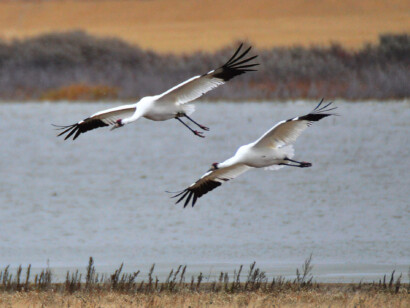Saskatchewan Whooping Cranes with Canadian Geographic Trip Report (2025)
This is a trip where everyone comes with the expectations of seeing at least one Whooping Crane. But who could expect to find 167 of them including an encouraging 17 juveniles in a single day! This area of Saskatchewan has so much to offer at this time of year, and on our Canadian Geographic tour we spent two nights in Prince Albert National Park. Many of the participants had quite a few requests for coveted boreal birds we might find there, and we were able to fulfill most of those requests…plus get some very neat mammals.
Day 1
That first evening, we gathered at the Park Town Hotel in downtown Saskatoon for a meet-and-greet, we got to meet our Royal Canadian Geographic representative, Fred Cattroll, and we got prepped for an exciting few days looking for the cranes and experiencing much of what the Saskatoon area and Prince Albert National Park had to offer. We had a really nice dinner in the hotel’s Four Seasons dining room where we got further acquainted. Some of the participants had arrived early and had been birding in and around Saskatoon so added quite a few species that one might not always get on this tour for Day 1 to our checklists — Hooded Merganser, Killdeer, Franklin’s & Herring Gull, Belted Kingfisher, Northern Flicker, American Kestrel, Peregrine Falcon, Northern Shrike, Swainson’s Thrush and Orange-crowned Warbler. After dinner, we retired early as tomorrow we would be headed right out to the best areas to find Whooping Cranes.

Fred Cattroll
Day 2
After a 7 am breakfast in the hotel, we headed north and west of Saskatoon bound for Blaine Lake. We started doing individual counts on some of the commoner birds (magpies, crows, ravens, Ring-billed Gulls and Rock Pigeons). In the agricultural fields, we spotted many flocks of field-feeding Canada Geese (conservative estimate of 2500 today) and as we got into more mixed agricultural/parkland habitat many larger flocks of Snow Geese (at least 40,000 today). But we had little time to waste in getting to the best Whooping Crane area as some might begin flying back to their daytime roosting lakes by mid morning.
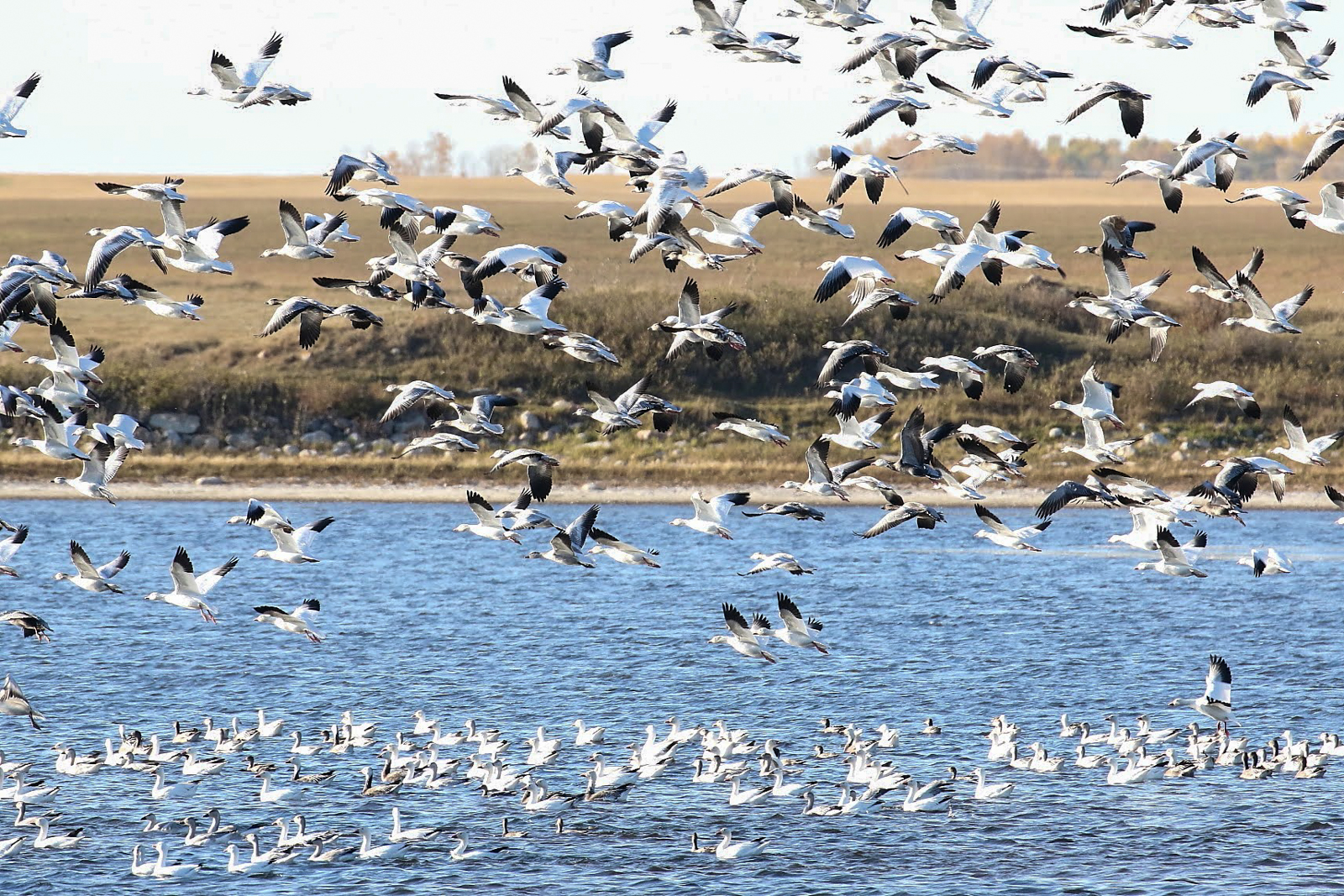
Snow Geese taking flight © David Forsyth
After a pit stop at Blaine Lake, we had a quick look at some sparrows while driving through Blaine Lake picking up White-crowned & White-throated Sparrows plus our only American Tree & Chipping Sparrows for this trip. On the way to Whooper country we spotted for some more sparrows (this time Savannahs) and brief looks at some Sharp-tailed Grouse. We hadn’t even got to our best starting spot for the Whoopers, when a couple dozen were spotted in a stubble field to our left; great looks and photos at this group including some with full-grown but rusty coloured young. After all had their fill with this first group, we pulled up a very short distance and found another group in a pond to our left. Again, great looks and these were close enough that we could see with binoculars that two of the adults with a juvenile were in fact banded.
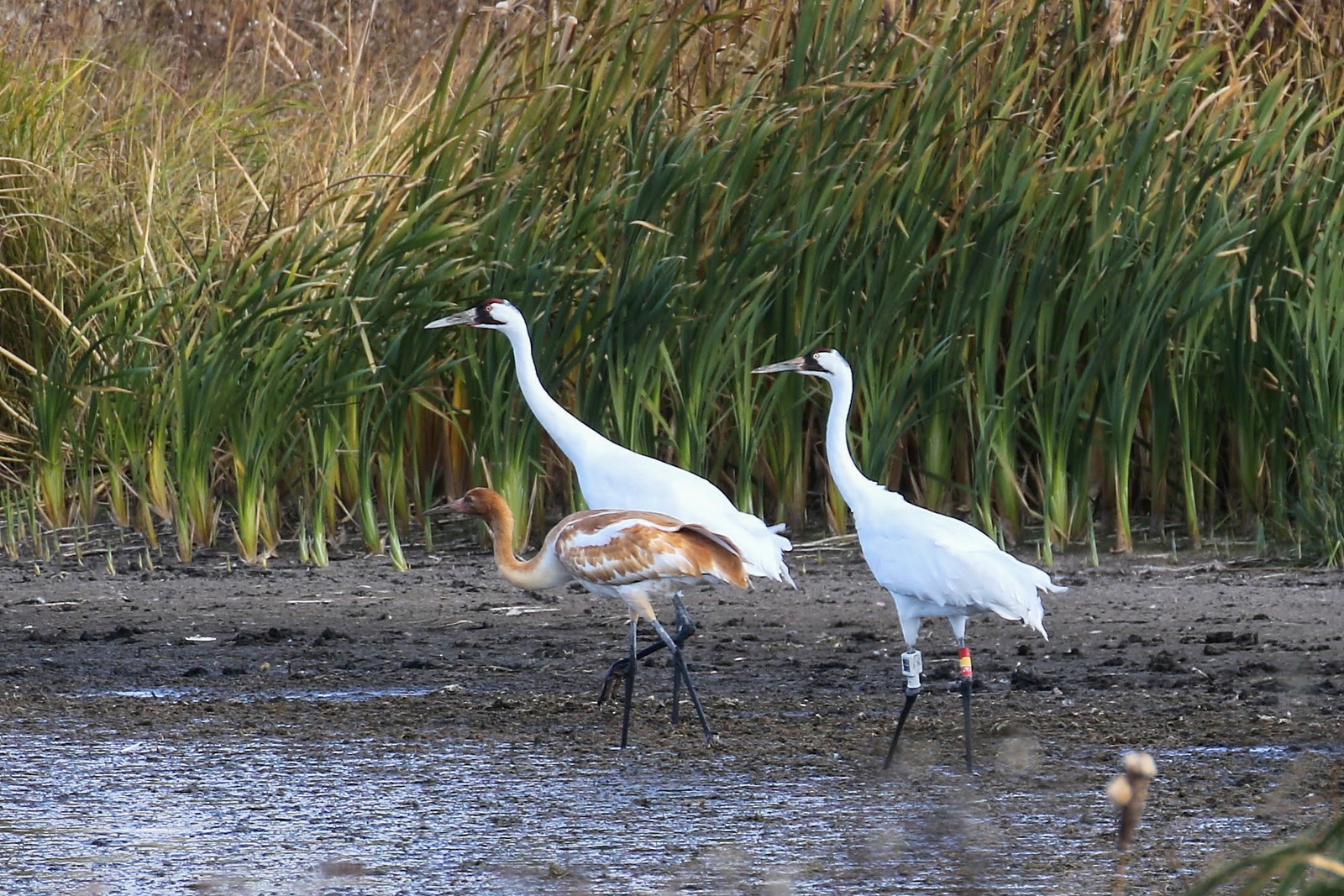
Whooping Crane family © David Forsyth
Turning east towards Marcelin, more Whooping Cranes were spotted in the distance, a coyote loped off across a field, and the first of a many Northern Harriers for the day hunted low over a marsh. At Marcelin, we headed north and west to a rise where another large group of Whoopers were spotted along with a few Sandhill Cranes. Backtracking a bit we got nice close-up looks at a Lapland Longspur before taking a north-bound trail where we spotted a Sharp-shinned Hawk, more flying Sharp-tailed Grouse, and some flocks of Lapland Longspurs circling and landing briefly to drink in some open water ponds. There were also a few more Whooping Crane pairs with young. As we neared Leask, we noticed another group of about 50 Whooping Cranes not too far off to our right. Including these, our total for the day was 167 including 17 juveniles!
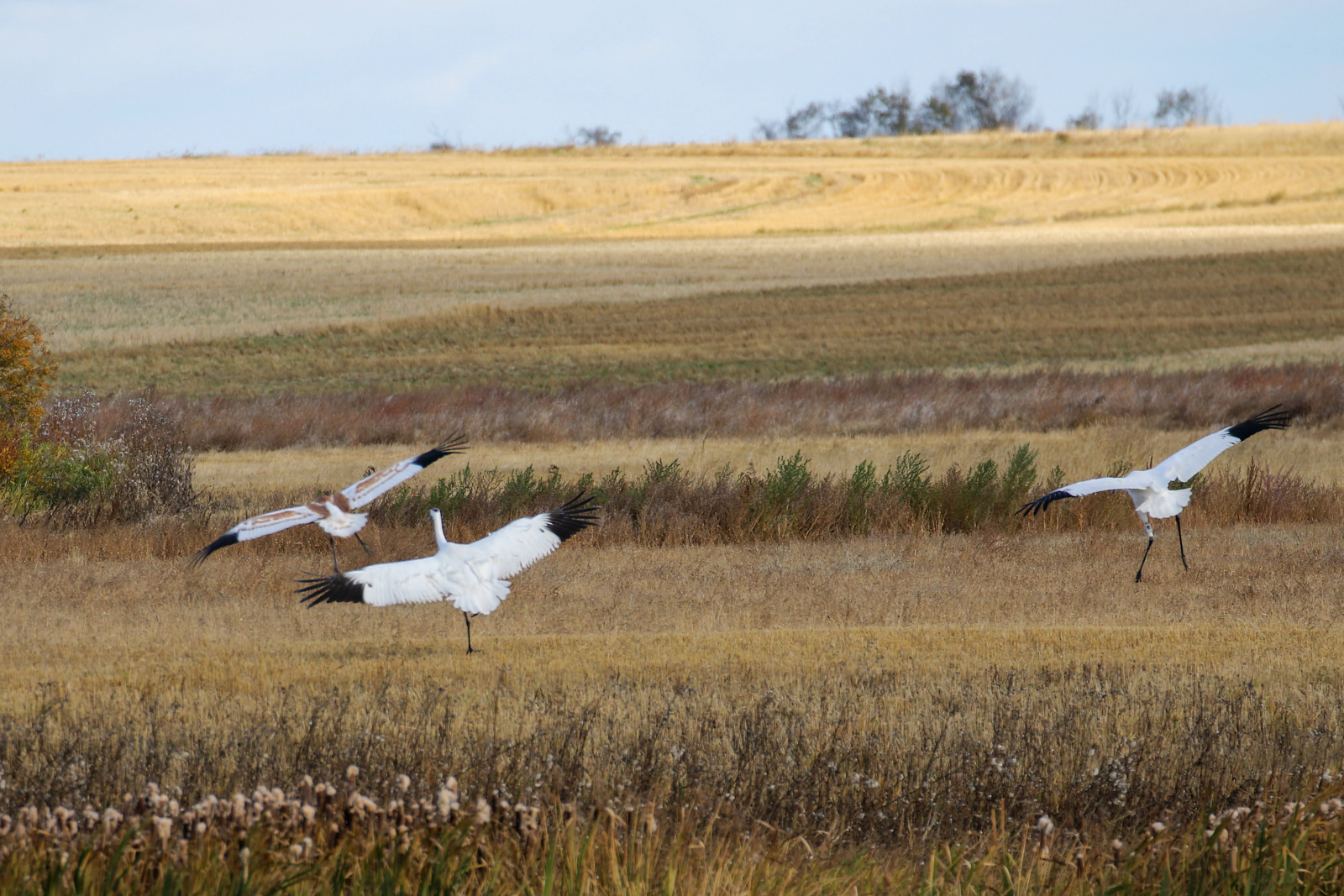
Whooping Cranes landing © David Forsyth
At Leask, we stopped at a large lake that was covered with several thousand Snow Geese, with many of the day’s 150 Ross’s, and a few Greater White-fronted Geese mixed in. We estimated there were at least 200 American Coots here, as well as the start of today’s 5 Bald Eagles and 30 Greater Yellowlegs. Two American Avocets were found, plus 5 Baird’s and 3 Semipalmated Sandpipers. In town, we used the vans parked next to our picnic table to shield us from a strong north breeze.
The afternoon was quite uneventful but we did tally up a few Western Meadowlarks, a couple Northern Flickers, an incredibly large group of 325 migrant Horned Larks, a Great Horned Owl, a Merlin, and a Ruffed Grouse that slowly strutted across the road. One van spotted a couple Mule and White-tailed Deer on the way back to Saskatoon where we had another very nice dinner downstairs at the hotel and revelled in a successful first day of the tour.
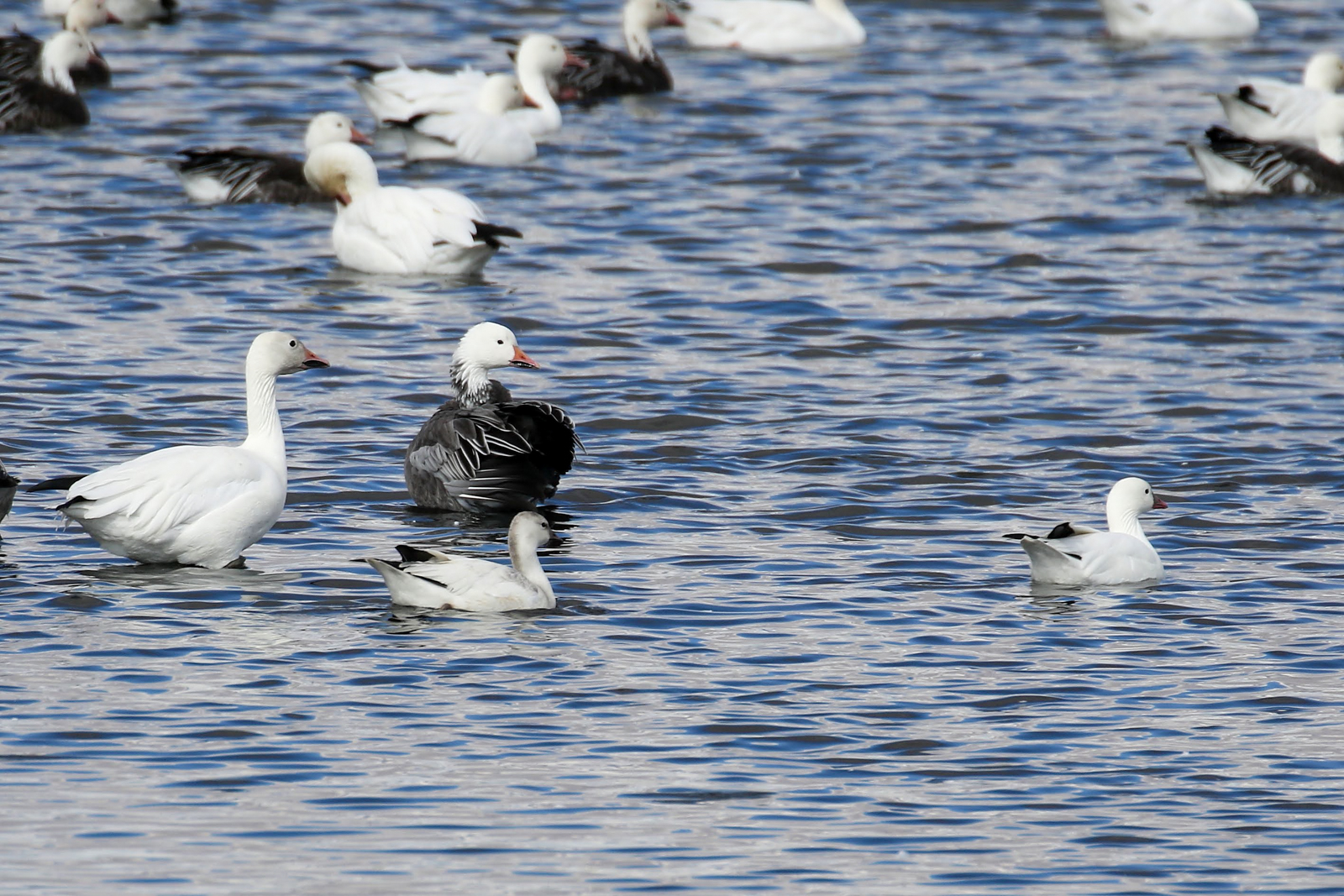
Ross’s and Snow Goose © David Forsyth
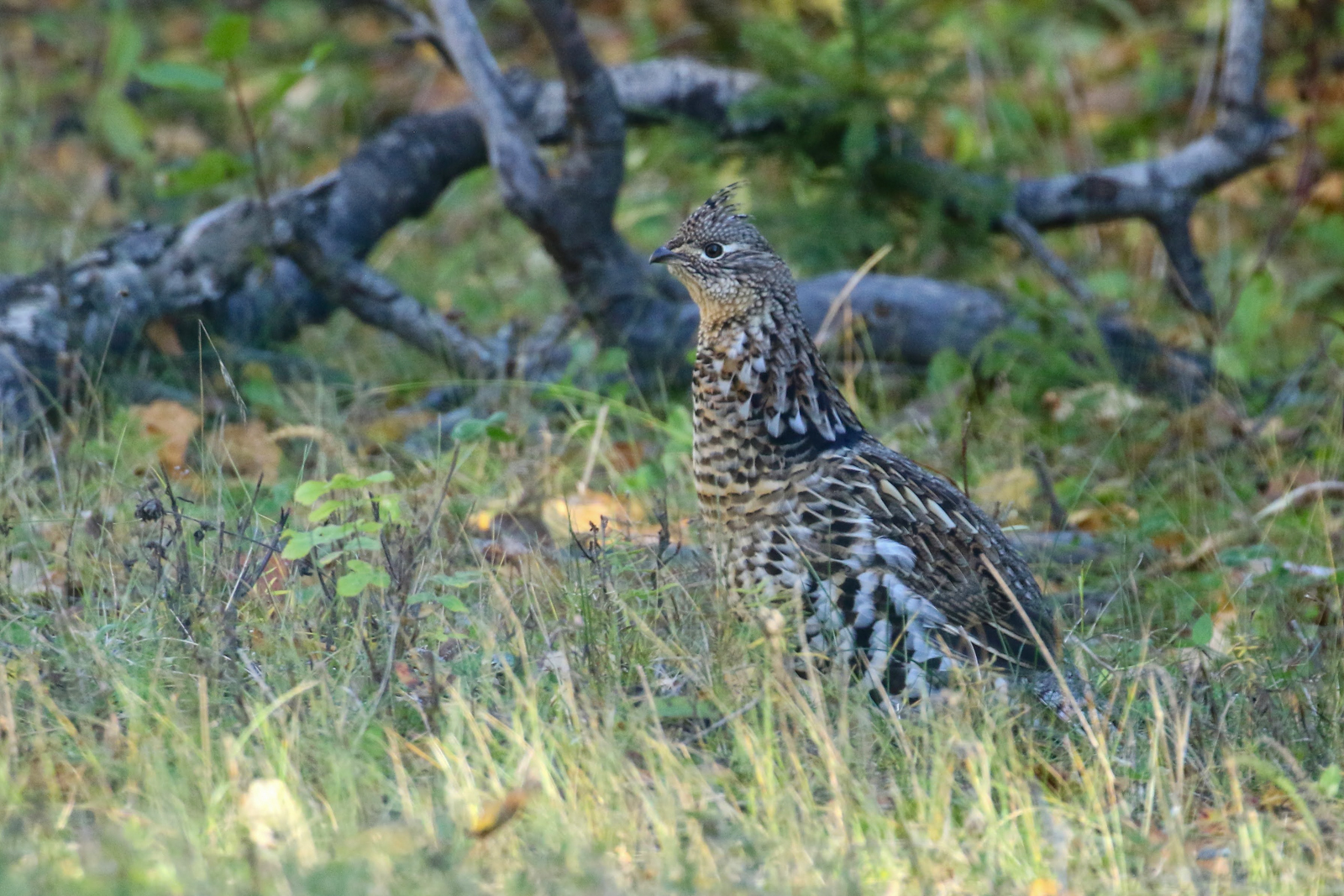
Ruffed Grouse © David Forsyth
Day 3
Today we would focus on sites in Saskatoon and then head south and east. First up was a stop at the Weir where we found a Belted Kingfisher and a few cormorants. A walk down the nearby back lane yielded a few Blue Jays, White-breasted and Red-breasted Nuthatches, Yellow-rumped Warblers, and most of the day’s 50 American Robins. After a pit stop at Meewasin Park, we hit the Forestry Farm which was unusually quiet with just a Brown Creeper (heard only) and a flock of 8 Rusty Blackbirds that were new. Heading south to Blackstrap we added a Mourning Dove and American Kestrel. At Blackstrap, we jogged to an upland trail where we had some nice close-ups looks at several Sharp-tailed Grouse. As we pulled up to our lunch spot in Blackstrap Provincial Park, we were excited to find a group of at least 5 Harris’s Sparrows, and during lunch we had some Cedar Waxwings, a Sharp-shinned Hawk that lit next to one of the participants, and a Purple Finch.
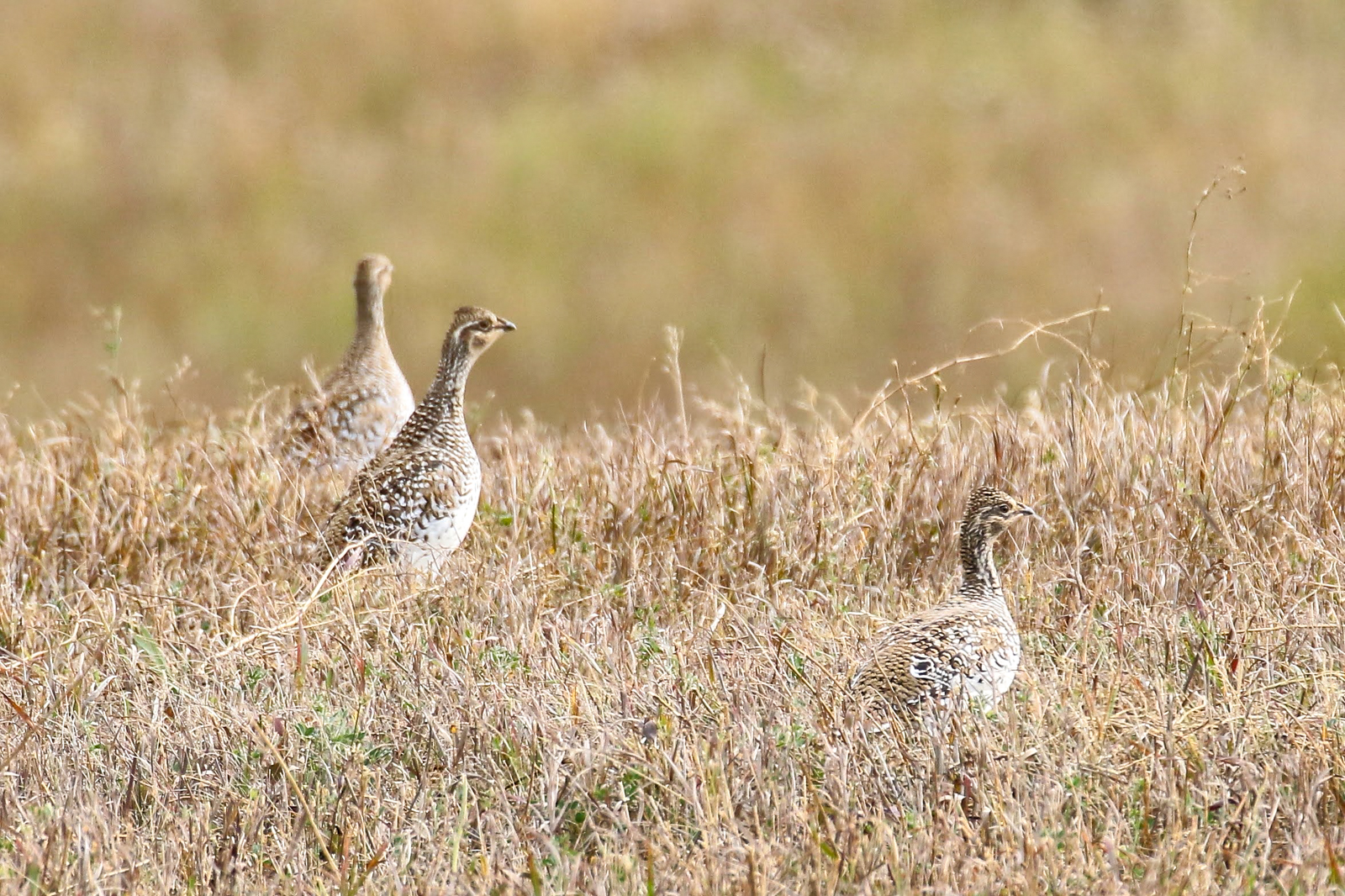
Sharp-tailed Grouse © David Forsyth
After lunch, we tallied at least 30 Bonaparte’s Gulls, a couple Common Loons and a Western Grebe on the lake, and a cute 13-lined Ground Squirrel along the roadway. Checking out the dam and some uplands at the north end of the lake, we scared up a flock of Gray Partridges, before heading south to Clavet. As we carried on north and east, we stopped at Chevriot Lake where we added an array of shorebirds (Killdeer, some Black-bellied & a Semipalmated Plover, 40 Long-billed Dowitchers, 40 Pectoral, 5 Baird’s, 4 Stilt & 3 Semipalmated Sandpipers). An American Pipit and a couple Red-winged Blackbirds were also new, as was a Porcupine ambling in a field nearby. A group of Sandhill Cranes was also found nearby, but we would add many more (1800 total for today), some Western Meadowlarks, and many of the day’s 15 Northern Harriers on the way to Crawford Lake. Crawford was white with an estimated 10,000 Snow Geese, a few Ross’s, White-fronted, Canada and Cackling Geese, and 50 Tundra Swans as a bonus.
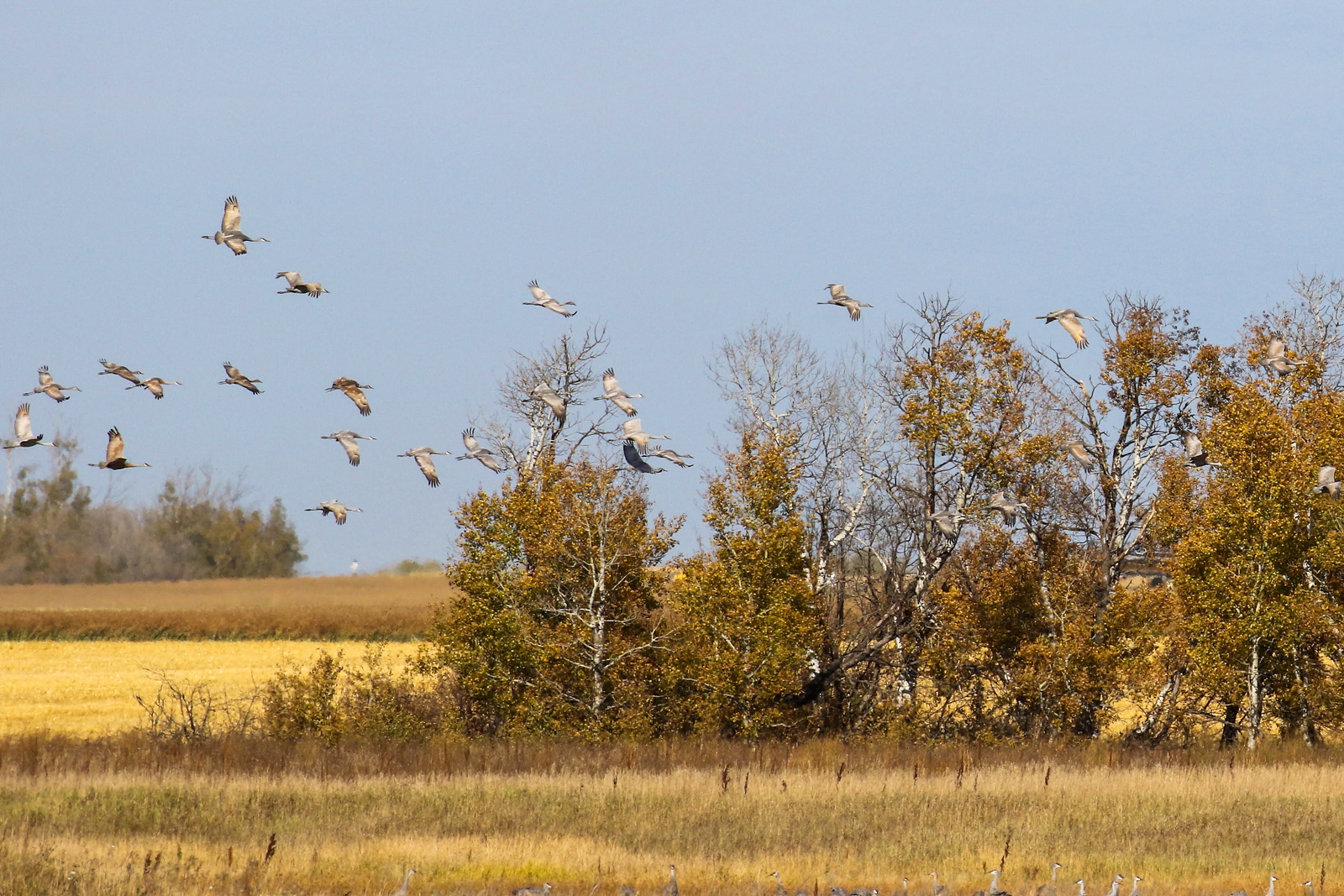
Sandhill Cranes flying © David Forsyth
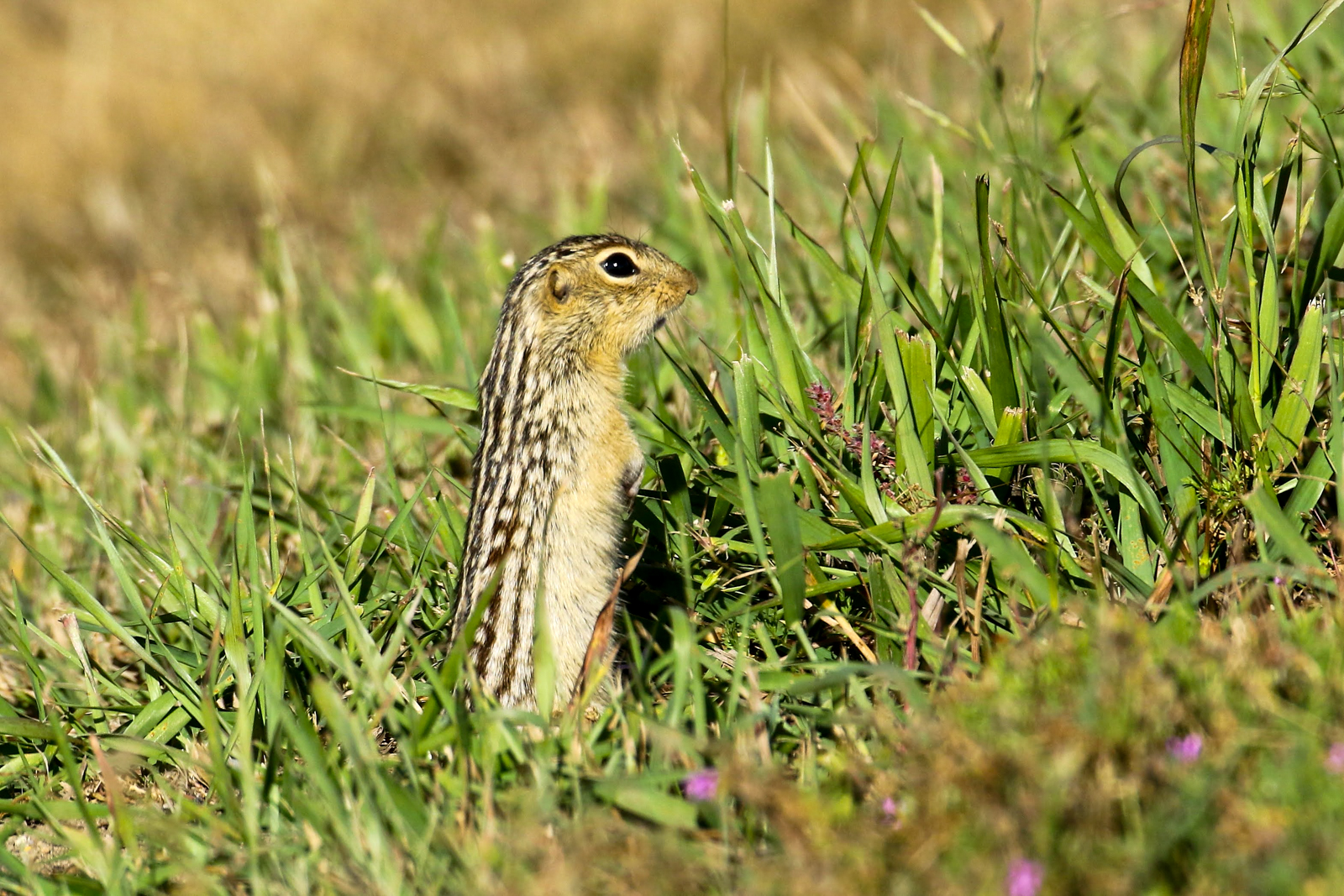
Thirteen-lined Ground Squirrel © David Forsyth
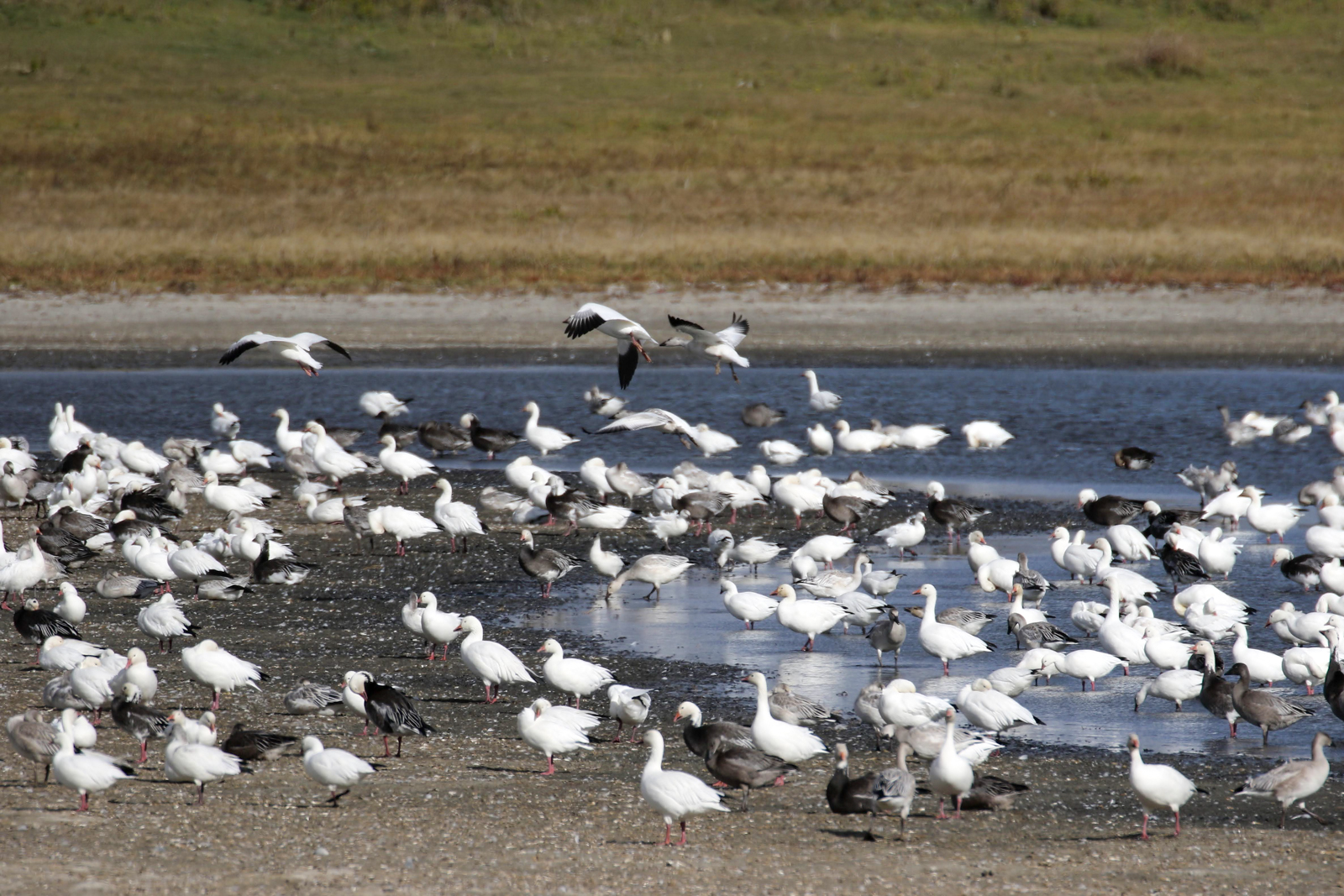
Snow Geese © David Forsyth
Our last destination for the day was Porter Lake where we took a look at just the closer ducks and had most of the day’s 7 Blue-winged & 100 Green-winged Teals, 200 Northern Shovelers, 65 American Wigeon, plus a few Mallards, Gadwall and Northern Pintail. For divers there were at least 300 Canvasback, 30 Lesser Scaup, plus a few Redhead, Bufflehead, Ring-necked and Ruddy Ducks. This lake also produced at least 200 American Coots, 6 Horned Grebes, and the tour’s only Pied-billed and Eared Grebes. But we only had time to check out a portion of the lake before retreating to the hotel where we enjoyed another meal downstairs and toasted another successful day.
Day 4
Today we would grab bag breakfasts from the hotel and get an early 7am start to Prince Albert National Park, stopping in Prince Albert for gas and some fresh coffee and snacks. Along the rather long drive to the park, we spotted some Red-tailed Hawks, a Sharp-shinned Hawks, a couple Bald Eagles and a coyote. A walk through a cottage development at Emma Lake was rather quiet today with only 8 Common Goldeneye, 30 American Wigeon, a Red-necked Grebe, and some heard only Evening Grosbeaks to add.
On to way to a nice riverside lunch spot in the park, we had a very nice roadside coyote and 14 Hooded Mergansers. Over lunch a few Canada Jays come in to investigate. Carrying on north to the Narrows, we stopped at Sandy Lake where we had a cooperative Richardson’s Ground Squirrel, some Common Loons and Red-necked Grebes on the water, and we took some group pictures. Further down the road we added a couple Ruffed Grouse and more Canada Jays. Along Narrows Road were a couple Pileated Woodpeckers, a Snow Bunting that posed nearby along the water’s edge, and 2 Swamp Sparrows. For mammals, we enjoyed watching a Muskrat, and later three roadside Beavers (one dragged a big branch from the woods, dove to place part of it in a feed pile, and then sat of the edge of its house feeding on the remainder of the branch).
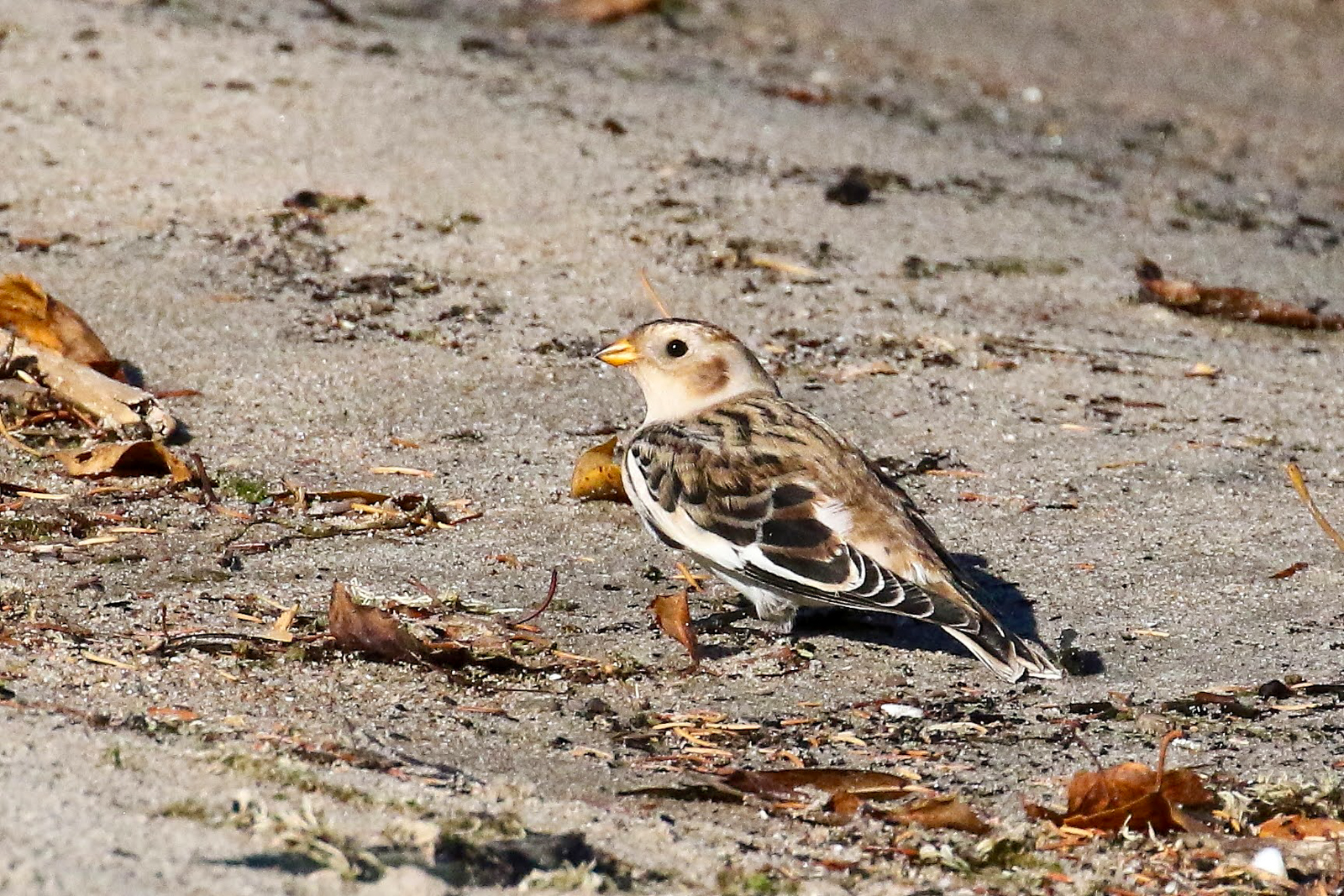
Snow Bunting © David Forsyth

Canada Jay © David Forsyth
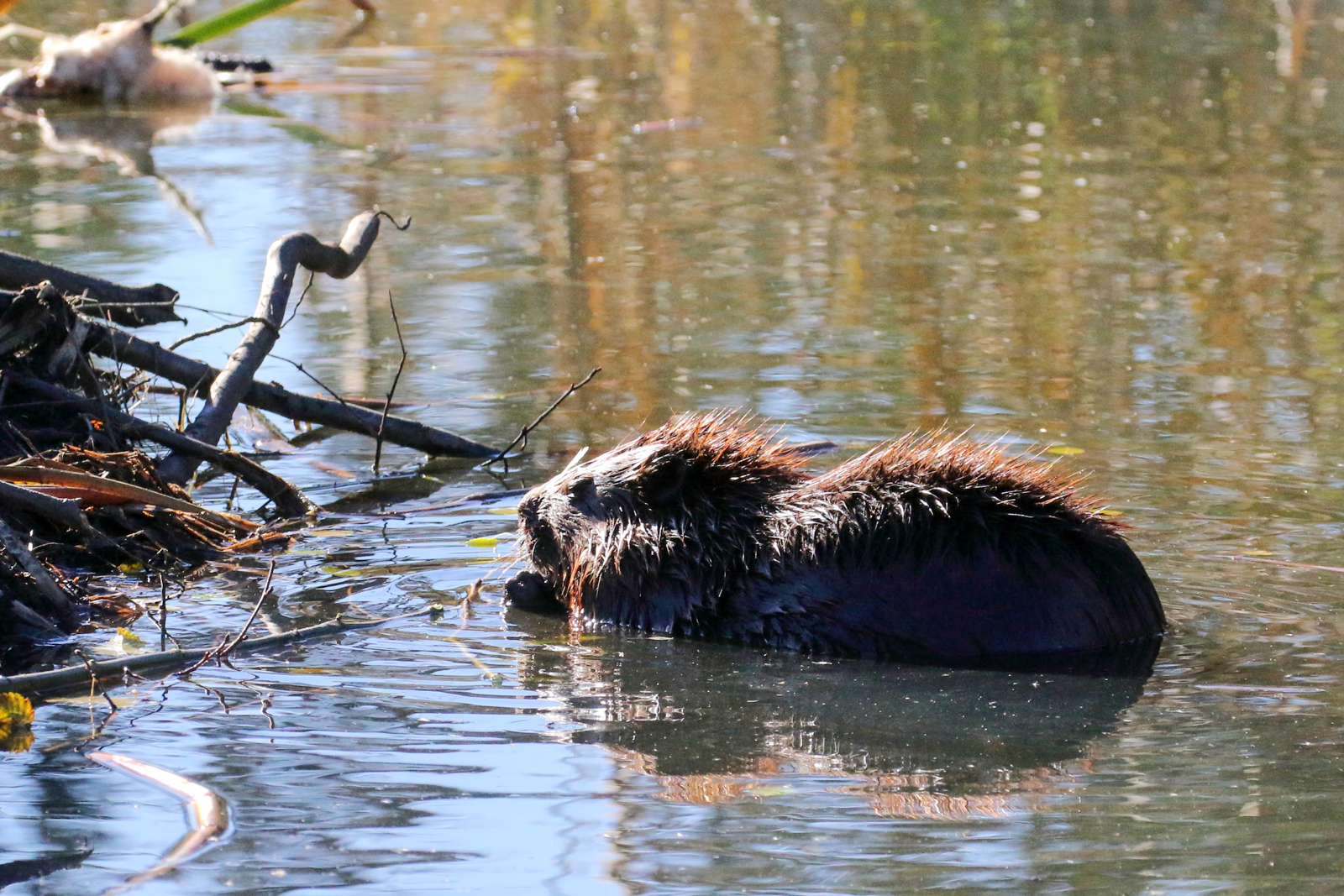
Beaver © David Forsyth
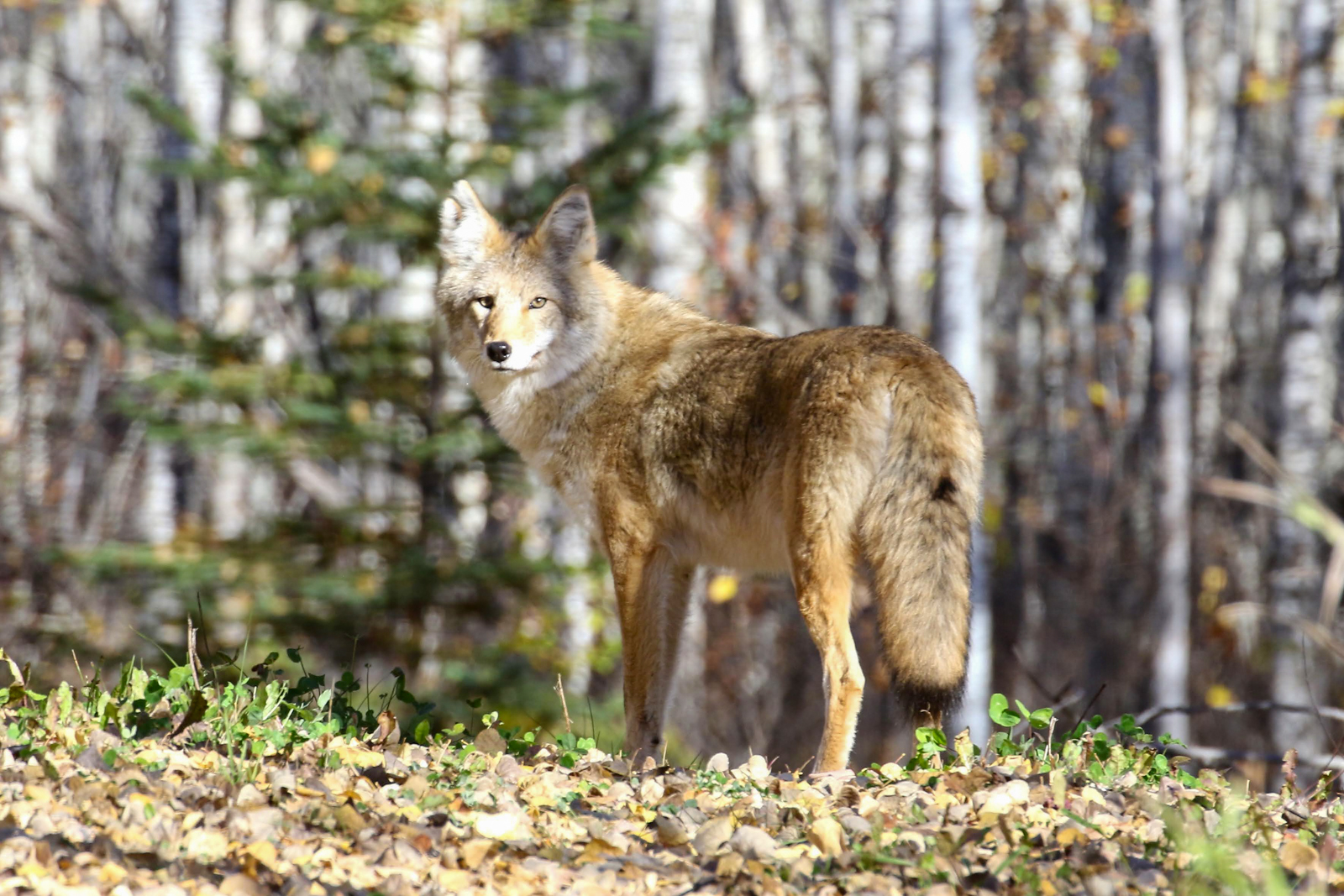
Coyote © David Forsyth
On to Waskesiu where we walked a stretch of the Red Deer trail where we had great looks at several Boreal Chickadees, some treetop White-winged Crossbills and a flock of Pine Siskins busily feeding on spruce cones. The real excitement, however, was when we learned of a Black Bear nearby and were able to find it and get superb photos. It was on to the Hawood Inn, where we checked in, had dinner, and tried the rooftop for northern lights after dark but there was none today.
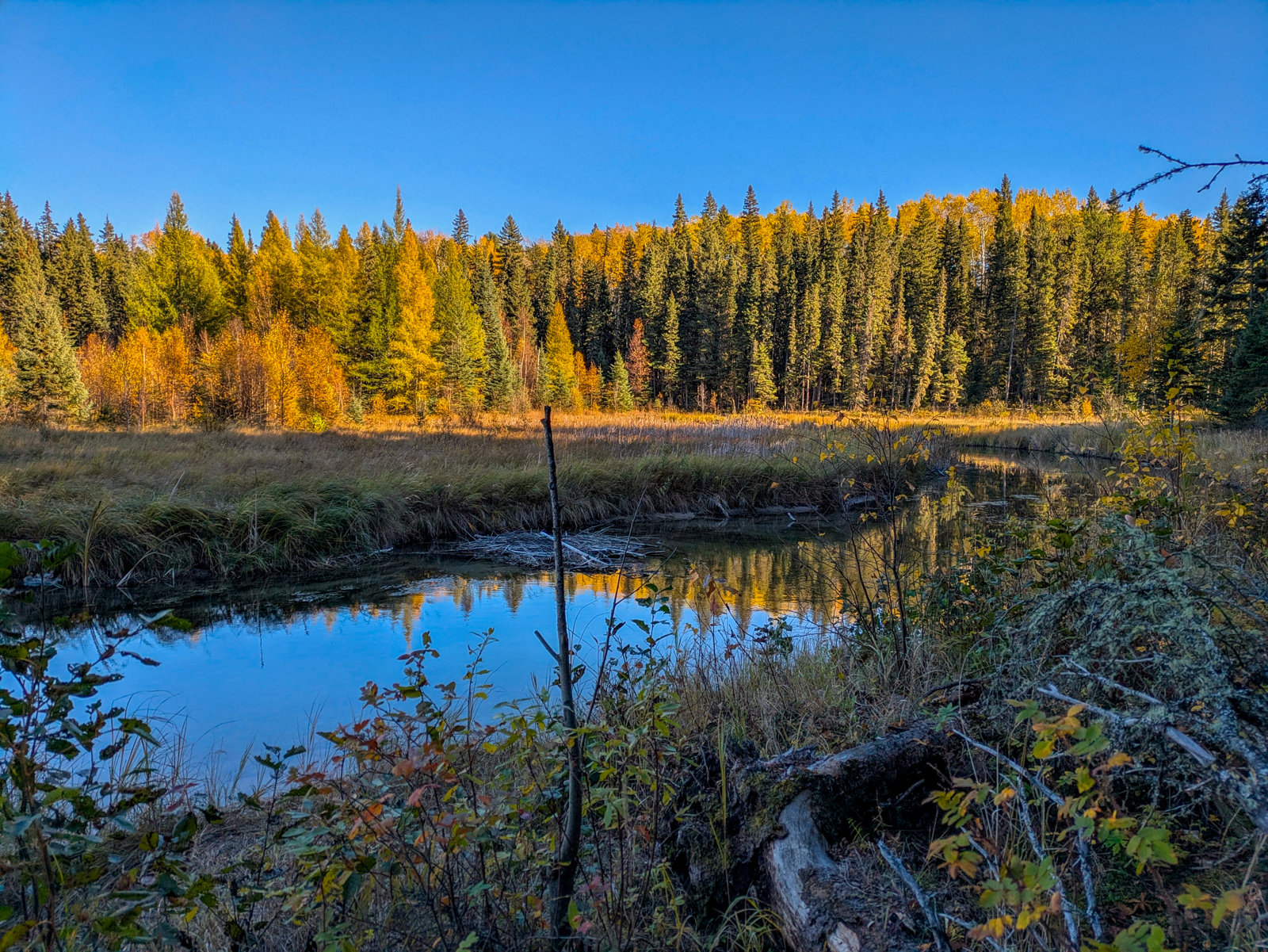
Saskatchewan fall colours © Melissa Cummins
Day 5
Today we explored Prince Albert National Park. We’d heard that a Pine Martin had been spotted at the Beaver Glen campground but we could not locate it. We once again checked out the north end of the Red Deer loop but it was very windy along it today and we saw little other than more Boreal Chickadees. Along the Narrows Trail, we’d had a gorgeous Cross Fox with the previous group, but we struck out again. We walked the very nice Treesbeard Trail where a Swainson’s Thrush was spotted. On the way back, however, we finally spotted the Cross Fox which walked right up to the vans for superb photos before trotting into the woods in search of prey. We stopped for lunch at a picnic spot on the south end of Waskesiu Lake and had some real curious Canada Jays come to investigate what we had for lunch.

Cross Fox © Josh Dewitt
After lunch, we drove around to the north end of Waskesiu Lake all the way to the Kingsmere Trail spotting no fewer than a dozen Ruffed Grouse but no hoped for Spruce Grouse. At a small lake we had 30 Ring-necked Ducks, but were surprised to find a pair of Trumpeter Swans. The Kingsmere Trail was picturesque but produced none of the hoped for woodpeckers. On the way back to the hotel, we had another surprise Black Bear (curiously, none had been found on any of the previous trips in the park over the last dozen or so tours)! We also we stopped a couple times for roadside elk on the way back. (**Ken De Smet – close-up Elk) It hadn’t been a superb day for highly desired boreal birds, but we’d found some new birds and saw some great mammals.
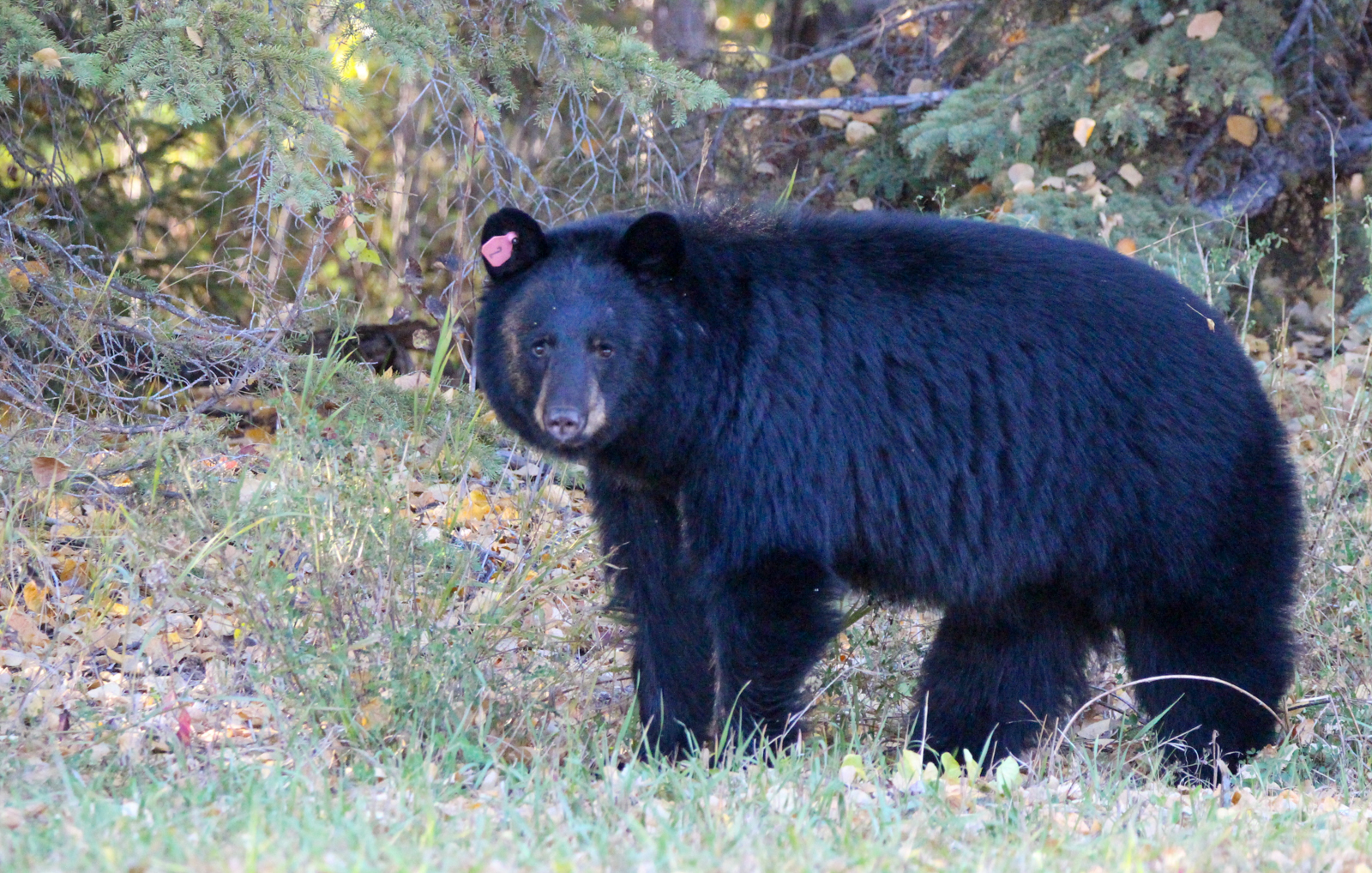
Black bear © Josh Dewitt
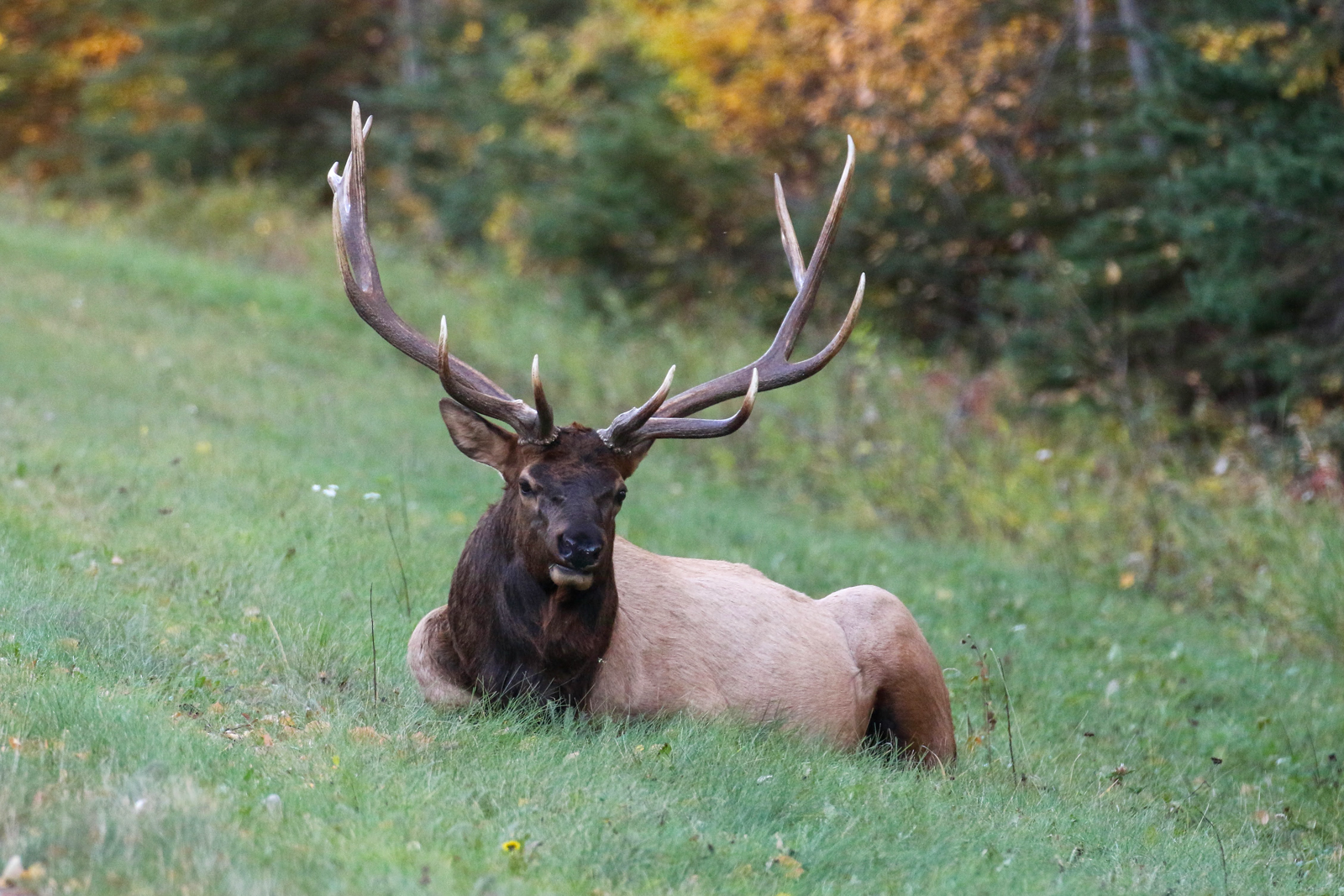
Elk © David Forsyth
Day 6
Today, we’d get to spend another half day and a bit in the park and it would turn out to be a banner day for the rest of the coveted boreal birds. We checked the Beaver Glen campground again as the habitat looked good for woodpeckers and we walked a stretch of trail settling for 3 Golden-crowned Kinglets and more Boreal Chickadees. We walked a stretch in town by the cabins where the woodpeckers often frequent but settled for a couple quite close-up bull elk. Stopping at the Park’s visitors centre, most checked out the gift shop but a couple participants went out back to see what was around. And there it was — an American Tree-toed Woodpecker. A few folks got onto it, but it flew off before the rest of the group saw it. Luckily, it was relocated some distance away and all got to see it this time. In the same area, 3 Brown Creepers were spotted and a couple Bald Eagles soared overhead.

American Three-toed Woodpecker © David Forsyth
The Boundary Bog Trail is probably the nicest of all the trails in the park traversing a lot of mature hardwood forest and with an extended walkway over boggy habitat and along a lake. One group took the longer route around the loop while those who didn’t want to walk as far took the shorter route. Both groups landed highly desired species; those that took the longer route found a Black-backed Woodpecker that all were able to get onto later, the group that took the shorter route picked up 4 Spruce Grouse! We had lunch back at the vehicles quite elated with our success on the trail and carried on to Marcelin for another look at the Whooping Cranes. Stopping at Leask Lake, we spotted 6 of the 19 Gray Partridge for the day, 125 Ross’s, and a few more Greater White-fronted and Cackling Geese. This time among a few Black-bellied Plovers, we also spotted an American Golden-Plover.

Black-backed Woodpecker © David Forsyth

Spruce Grouse male © Melissa Cummins
We had gone not far west of Leask when we spotted our first Whooping Cranes, a huge feeding congregation of over 100 birds. Sweeping around to the Marcelin road, we found more Whoopers, amassing a total of 138 including 14 juveniles in short order. On the way back to Blaine Lake and proceeding back to Saskatoon, we added 11 Sharp-tailed Grouse, 7 Northern Harriers, 2 Mule & 5 White-tailed Deer, 2 Coyotes, a Red Fox, at least 17,000 Snow Geese and over 1800 Canada Geese!
Back at the hotel, we celebrated a most productive day as we enjoyed our last meal together. Afterwards, we each got to reminisce about our favorite species and/or moments from the trip — and there were more than enough to go around twice! We then said our goodbyes as many would be leaving early the next morning.

© David Forsyth
Day 7
A few of us that remained met over breakfast the following morning. In retrospect, this group had really meshed well, we’d had a great time, and accumulated a record 112 species of birds, 13 mammals, and a whopping 167 Whooping Cranes in a single day (about one-third of the world’s wild Whooping Crane population)!
Josh and I thank you all for your great company, camaraderie, and stories. Special thanks to our Royal Canadian Geographic rep, Fred Cattroll, who had many great stories for all and especially good advice for the photographers. Here’s hoping we’ll see some of you again in the future, perhaps on an Eagle-Eye tour in Manitoba or some other exotic location.
Your ever-appreciative guides, Ken & Josh.

Our Group © Fred Cattroll
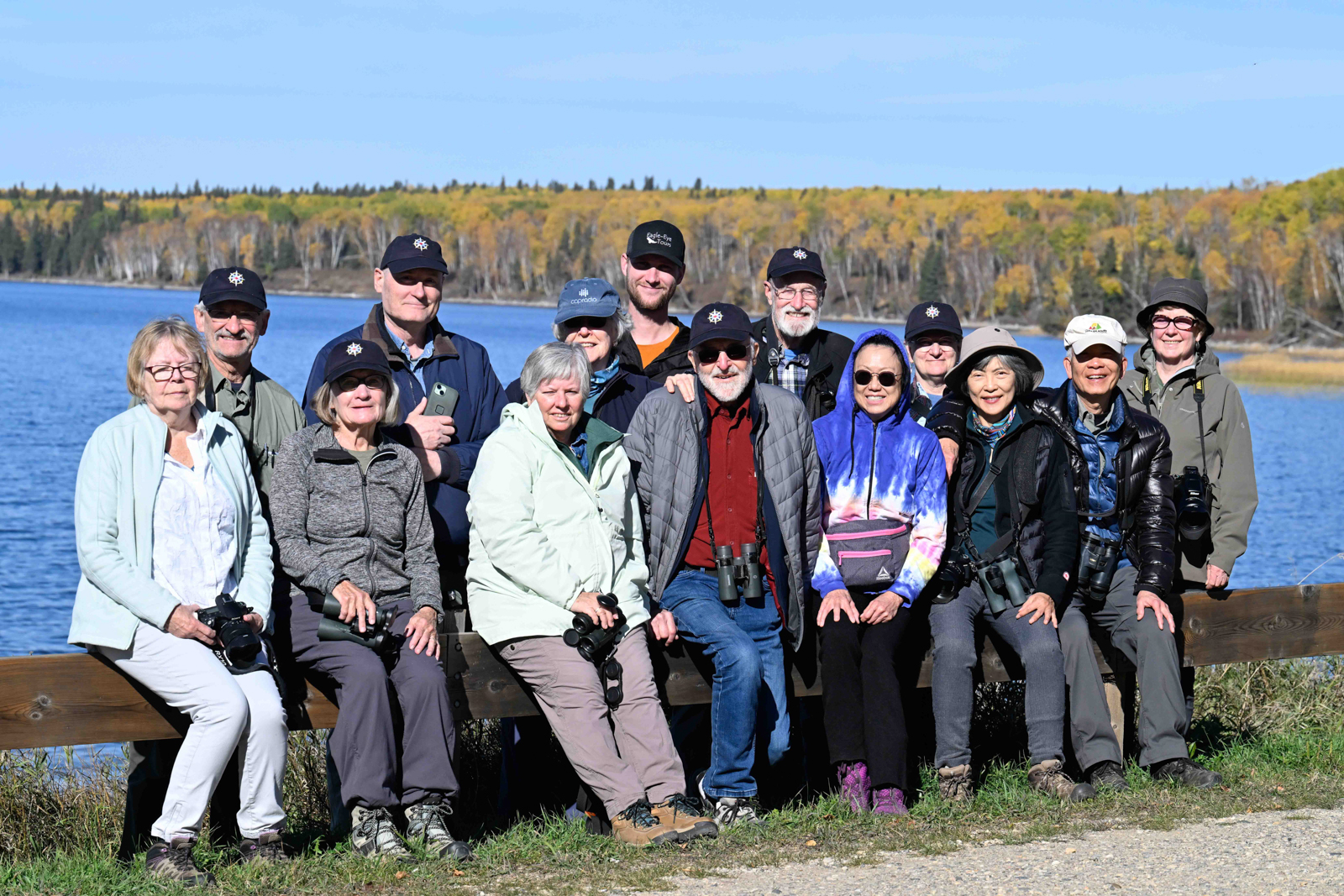
Our Group © Fred Cattroll
Saskatchewan Whooping Cranes with Canadian Geographic eBird list 2025


